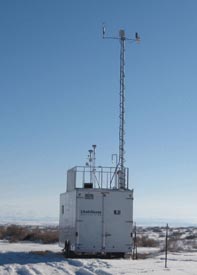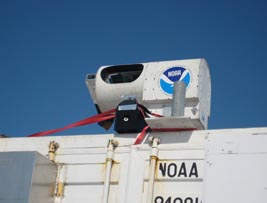Teams of scientists continued their work in the Uinta Basin in 2013 to identify the sources and conditions that create ozone during winter inversions. The Division of Air Quality (DAQ) and its partners collected additional data to improve their understanding of the atmospheric chemistry that leads to the formation of wintertime ozone in the Basin.

Key Findings
The 2013 Uinta Basin Ozone Study (UBOS) experienced far different wintertime conditions than the 2012 study, when minimal snow cover kept the 8-hour average ozone levels below the federal air quality standard of 75 parts per billion (ppb). Persistent snow cover in 2013 led to inversions, which in turn resulted in ozone concentrations well above the NAAQS.
Maximum 8-hour average ozone concentrations at the Ouray air monitoring station during the 2013 study period reached 142 ppb, 89 percent higher than the federal air quality standards. Ozone values exceeded the NAAQS for 22 days in Vernal and 29 days in Roosevelt. Individual episodes of elevated ozone ranged from 3 to nearly 15 days in length.
Air Quality
- VOC and NOx are the primary chemical precursors of ozone.
- High ozone levels coincided with elevated levels of methane, VOCs, and odd nitrogen species (NOy).
- A review of all emissions sources within the Basin indicates that activities associated with oil and gas exploration and production are the predominant sources of ozone precursors.
- The air pollution associated with ozone episodes is confined to a shallow boundary layer that varies in height from 230 feet to 1,300 feet above ground level.
- Ozone concentrations within the Basin are not influenced to any significant extent by the transport of ozone or its precursors from outside of the Basin or the Bonanza Power Plant.
Meteorology
- Elevated winter ozone levels only occur with snow cover that leads to temperature inversions.
- Reflection of sunlight from the snow surface significantly increases the rate of ozone formation, by roughly 50 percent.
- Complex patterns of light winds appear to contribute to intra-basin mixing of ozone and ozone precursors.
- Obtaining accurate results with current modeling techniques will be very challenging. Additional data collection and model development will be necessary to produce a good working model for evaluating regulatory strategies.
Chemistry
- Nitrous acid (HONO) and formaldehyde were found to be the biggest contributors to the creation of the chemically reactive radicals that drive ozone formation. The magnitude of HONO’s contribution is uncertain at this time.
- Measurements suggest that VOC reactions in the snow may contribute to ozone chemistry within the air just above the snow surface.
- Oxidation of VOCs is a key step in ozone accumulation. Measurements indicate that alkanes are much more abundant and likely contribute more to Basin ozone formation than the more reactive but less abundant aromatic VOCs such as toluene and xylene.
- There do not appear to be large sources of other highly reactive VOCs (alkenes).
Emissions
- Formal coordination between DAQ, EPA, federal land managers, and energy producers is needed to help fill current data gaps in emission inventories.
- While emissions from produced water ponds comprise a small part of the VOC emissions in the Basin, VOC emitted from ponds tend to be enriched in reactive VOC.
- Field measurements showed significant differences in VOC emission composition depending on well and equipment types.
- Complex regulatory jurisdictions and inconsistent reporting requirements complicate efforts to obtain comprehensive emission data for the Basin.
- Inventory data specific to the winter ozone season are needed as some sources have large seasonal variations.
- Additional information is needed on sources of formaldehyde, a highly reactive VOC that accelerates the formation of ozone.
- Emissions of VOCs from storage tanks, leaking equipment, venting, blowdowns, and other intermittent events need to be better quantified.
Control Strategies
- Uncertainties remain regarding the likely impact of nitrogen oxides (NOx) and volatile organic compound (VOC) emission controls on ozone levels.
- Analysis from 2012 data suggests that VOC reductions would produce ozone reductions while marginal NOx reductions may result in increases in ozone, but further analysis is needed.
- The effectiveness of NOx controls will be impacted by the extent to which unreactive NOz (reservoir species) are being recycled into reactive NOx.
Study Partners
The Uinta Basin Ozone Study (UBOS) is a collaborative effort between county, state and federal entities, industry organizations, and higher education. Researchers for the UBOS 2013 include:
- Utah State University (USU)
- National Oceanic and Atmospheric Administration (NOAA)
- University of Colorado, Boulder (CU)
- University of Wyoming (U of WY)
- University of Washington (UW)
- Utah Department of Environmental Quality (DEQ)

Funding and in-kind support for UBOS 2013 came from:
- The Uinta Impact Mitigation Special Service District (UIMSSD)
- Western Energy Alliance
- Bureau of Land Management (BLM)
- National Oceanic and Atmospheric Administration (NOAA)
- Environmental Protection Agency (EPA)
- Utah Department of Environmental Quality (DEQ)
- Utah Science Technology and Research Initiative (USTAR)
- Utah School and Institutional Trust Lands Administration (SITLA)
- Uinta Basin 2012/13 Winter Ozone Study Plan and Budget
Draft Version 1.2; November 20, 2012.

